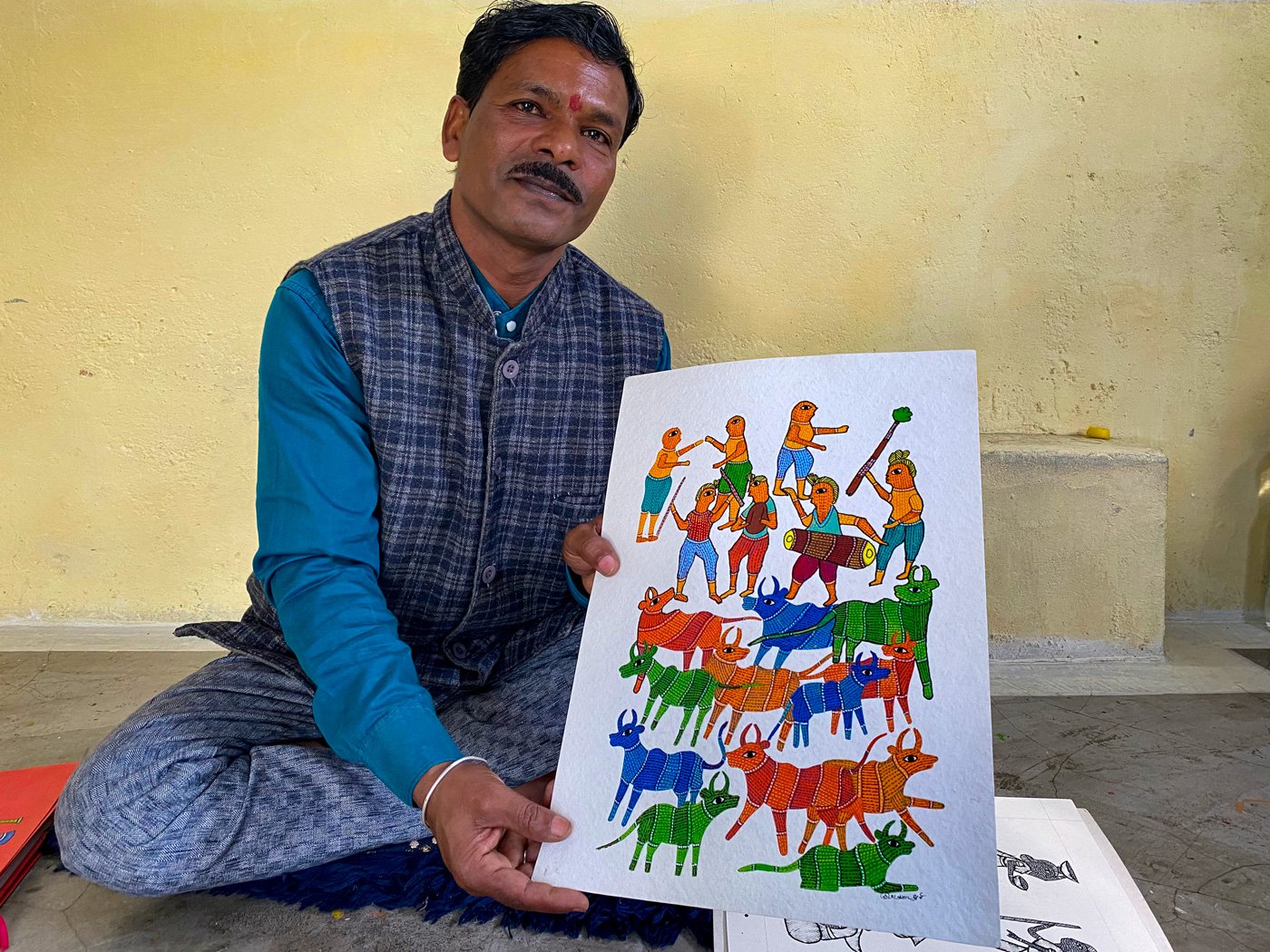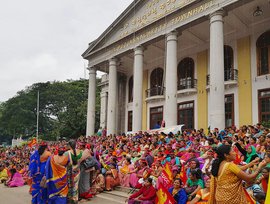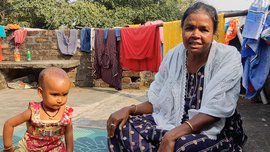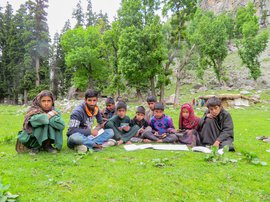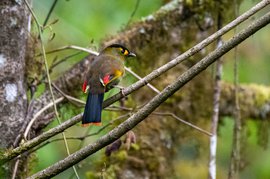“In the evening, all animals come to rest here. It’s a bargat [banyan] tree.”
Suresh Dhurve is talking as he applies deft paint lines to the poster-size paper he is working on. “This is a peepal tree and more birds will come and sit on it” he tells PARI, drawing more branches for the large, welcoming tree.
The 49-year-old Gond artist is sitting on the floor of his house in Bhopal, Madhya Pradesh. Light filters through a tree from the door and windows of the room on the top floor. On the ground next to him is a small jar of green paint that he keeps dipping into. “Earlier we used to use bamboo sticks [as brushes] and ghileri ke baal [squirrel hair] as bristles. That [squirrel hair] is banned now, which is good. Now we use plastic brushes,” he says.
Suresh says his paintings tell stories and “when I am painting I have to spend a lot of time thinking what to make. Let’s say Diwali is coming, I must think of all things around the festival like cows and diyas .” Gond artists recall living creatures, the jungle and the sky, legends and folktales, farming and social engagements in their work.
It was Jangar Singh Shyam came to Bhopal, and began drawing first on cloth and then on canvas and paper. Gond artists recall living creatures, the jungle and the sky, legends and folktales in their work
Suresh was born in Patangarh Mall – the village from which all Gond artists in Bhopal like him, trace their lineage. The area lies south of the Narmada river and is surrounded by forests of Amarkantak-Achanakmar Tiger Reserve. The latter is teeming with wild animals, varieties of trees, flowers, birds and insects, visible in all Gond paintings.
“We used to make paint from things we found in the jungle – the green leaves of the semal [silk cotton] tree, black stones, flowers, red mud, among others. We would mix it with gond [resin],” he recalls. “Now we use acrylic. People say using those natural colours will get a better price for our work, but where do we get it from?” he adds as forests are shrinking.
Gond painting was a wall art on tribal homes in the village, done for festivals and weddings. It was in the 1970s that celebrated Gond artist Jangar Singh Shyam came to the state capital Bhopal, and began drawing first on cloth and then on canvas and paper. He is credited with creating a new form of the art – on paper and canvas. The late artist received the Shikkar Samman – the state’s highest civilian honour in 1986 for his contribution.
But in April 2023, when Gond art finally received a Geographical Indication (GI) tag, Jangar’s community of artists were ignored and the GI was awarded to the Bhopal Yuva Paryavaran Shikshan Evam Samajik Sansthan and the Tejaswani Mekalsuta Mahasangh Gorapkhpur Samiti, in Dindori district. A move that has upset the Bhopal artists, family and followers of Jangarh Singh. The late artist’s son, Mayank Kumar Shyam says, “we want the name of Jangar Singh to be among the names of GI applicants. Without him there would be no Gond art.”


Left: The Geographical Indicator certificate for Gond art, awarded in April 2023. Right: Bhopal artists Nankushiya Shyam, Suresh Dhurve, Subhash Vayam, Sukhnandi Vyam, Heeraman Urveti, Mayank Shyam
Quick to respond, the Dindori District Collector, Vikas Misra who pushed for the GI said on the phone, “the GI tag is for all Gond artists. We are not discriminating based on where you live. Artists from Bhopal can call their art ‘Gond’ as they are all from here. They are the same people.”
In January 2024, the Bhopal group of Jangarh’s followers – Jangarh Samvardhan Samiti submitted a letter to the GI office in Chennai asking for their name to be added as applicants, but till the time of this story being published, nothing had changed.
*****
Growing up in Patangarh, Suresh, the youngest and the only boy in the family, was trained by his father, a skilled artisan who could work on different materials. “He could make Thakur Dev statues, engrave and etch dancing figures on doors as decorations. I don’t know who taught him, but he could do so many things – from masonry to carpentry.”
As a young child, he moved around with him, picking up skills as he watched. “ Miiti ka kaam hota tha [We made idols of clay for festivals]. My father’s work with wood was done for people in our village. But it was more of a shauk [hobby] , so he didn’t earn money for this work. At best he would get some food – grain was the currency. So about half or one paseri [five kilos] of grain of wheat or rice,” he recalls.


Suresh (left) was born in Patangarh Mall – the village from which all Gond artists in Bhopal like him, trace their lineage. The area lies south of the Narmada river and is surrounded by forests of Amarkantak-Achanakmar Tiger Reserve. The latter is teeming with wild animals, varieties of trees, flowers, birds and insects, visible in all Gond paintings (right)
The family had only a small parcel of rain-fed land on which they grew paddy, wheat and channa for their consumption. The young Suresh worked on others’ fields: “I could earn 2 and half rupees for a day’s work in someone’s field or land, but it was not available daily.”
In 1986, the young boy was orphaned at the age of 10. “I was completely alone,” he recalls, his older sisters were all married, so he had to fend for himself. “One day Jangar’s mother, who had seen my art on walls in the village, thought why not take me along [to Bhopal]. ‘He can learn something’,” he says. They travelled over 600 kilometres from eastern Madhya Pradesh to the capital city.
Jangar Singh was working in Bhopal’s Bharat Bhavan then. “Jangar ji, I called him ‘ bhaiya ’. He was my Guru. He put me to work. I had never worked on canvas before, I had only worked on walls.” His job initially was to get the right colour by “ ghis ghis ke [continuously rubbing] the stones and other materials.”
That was four decades ago. Since then, Suresh has created his signature – ‘Seedhi Peedi’ design. “This you will see in all my work,” he says. “Let me show you the story in this painting…”
